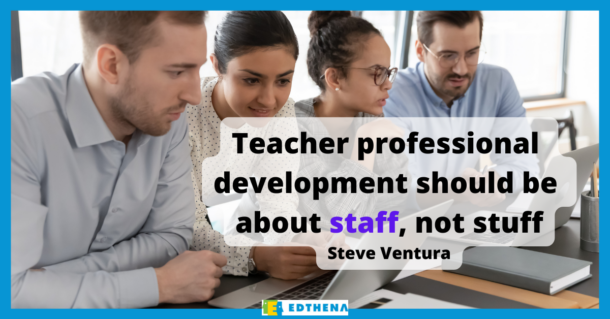Effective Teacher PD Starts with Asking, What is Really Helpful?
-
-
Effective teacher PD leads to positive student outcomes
-
Give teachers time to practice what they’ve learned
-
Provide teachers with feedback on their implementation
-
Who hasn’t heard a teacher groan, “Another one?” when ‘teacher professional development’ is put on their schedule?
Unfortunately, teacher PD has become a dirty word. Educators’ plates are full and they don’t always see the value in another PD session or tool.
Steve Ventura, CEO of Advanced Collaborative Solutions, is here to flip the script. As a teacher professional development consultant, he is adamant about respecting and making the most of teachers’ time.
Steve talked to Edthena founder Adam Geller for a PLtogether Lounge Talk. The two discussed how effective teacher PD starts by setting priorities and considering what is worthy of teachers’ time.
Watch the full conversation above, or continue reading for highlights.
Make sure your professional development is worth teachers’ time
What makes effective teacher PD… effective? It’s about going deeper instead of trying more things.
“The respect that administrators give to teachers for professional development should be an extension of where the school really is and what the school actually needs to improve on! … I don’t think we should be investing in a lot of new initiatives,” remarked Steve.
The argument stems from the fact that teachers are already constantly trying new strategies, curricula, tech tools, and more in their classrooms.
So, when they ask, “Why do I need to learn this?”, they’re really wondering, “When am I going to find time for this?”
From his own experience as a school leader and superintendent, Steve Ventura suggested that leaders take other things off teachers’ to-do lists before adding more on.
“Teachers don’t have time to give [new initiatives] a hundred percent implementation.” Steve continued, “[School leaders] need to make a commitment to say, ‘Yeah, we’re going to go deeper with fewer things. And here’s the things you don’t have to do anymore.’”
This is when school leaders have the opportunity to prioritize what will ultimately make the most impact on students. The initiatives they choose for teachers have to be timely, understandable, and valuable.
It’s also helpful for school leaders to ask teachers directly when presenting a PD, “What do we really need? What will help the most?”
Making clear how and why a PD initiative is important, and taking away others that aren’t, are key to giving teachers the time they need with what will matter most.
Don’t replace teacher practice with tech support
Another teacher time-waster is serving up tech support for new apps or programs, instead of true teacher professional development.
Instead of spending time learning new gadgets, sometimes teachers just need practice time.
“Teachers should have the opportunity to continue to practice what they’ve already been taught during professional development because that would give them more time to go deeper,” said Steve Ventura.
It’s not necessarily about doing less technical training, but about deciding if the technical tools are even right for what will improve student outcomes. And often, what will impact students the most is teachers having the time to practice what they’ve learned.
Effective teacher PD leads to actual changes in a teacher’s practice in the classroom.
Steve emphasized, “A program will never have as much impact as teacher practice. … Professional development should be about staff, not stuff.”
Tech tools are helpful for professional learning, but sometimes the greater investment should be in teacher practice.
Give teachers feedback on the actual implementation of what they learn
It’s no surprise to us that giving teachers feedback is important to their growth.
So then why are teachers sometimes left to implement what they’ve learned with no follow-up?
“Why would [teachers] invest so much of their time and energy into learning something new if no one’s going to give them feedback about how well they’re doing it?” posed Steve.
When teachers take what they’ve learned and are able to practice it, that’s still not enough.
Receiving feedback is integral to teachers understanding if they are implementing a new program or tool effectively.
Effective teacher PD doesn’t scare off educators
Teacher professional development can have a negative connotation if the educators in your building feel it’s not a good use of their time.
Avoid the PD blues by ensuring that the content delivered is what matters most for teachers’ teaching. Then, make sure they have the time to practice what they’ve learned and receive feedback on it for continued professional learning.
For more insights, check out all of our conversations with Steve Ventura.

